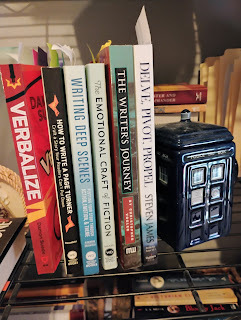A Book Group for Writers!

Recently I participated in a book club, hosted by Lorin Oberwegerand Free Expressions, that was as much a writing group as it was a readinggroup. It proved inspirational andinformative as any MFA program. The process followed that first the group read anddiscussed a craft book, in which the author of the book offered furtherinsights into the concepts as well as guided writing exercises. At the nextmeeting, group members applied these concepts to a work of fiction, in whichthe author also presented further insights into their writing process.
Below I review some of my favorite craft books, most of whichI had not read before. I’ve not included any of the fiction in lieu of space. (Albeit,a couple of my favorites include Henry Neff’s Witchstone and Nina Simon’sMother-Daughter Murder Night). The key here is to learn how to deep dive intothese concepts, apply them to your current read, and by extension, your currentWIP.
How to Write a Page Turner: Craft a Story Your Readers Can’tPut Down (Jordan Rosenfield, 2019). According to Rosenfield, a “good story is acreated, stylized and crafted version of reality. And tension, with its elements and tools, areessential to the transformation of the ordinary into the extraordinary. Herbook explores the four building blocks of tension, including danger, conflict,uncertainty and withholding. This is a must read.
Writing Deep Scenes: Plotting Your Story Through Acton,Emotion and Theme (Jordan Rosenfeld, 2015). Albeit not on the reading list, Ienjoyed her discussion on page turners so much, I decided to read this one,too. Rosenfeld defines plot as “the events that take the protagonist from thedarkness of not knowing what is happening to the light of solving the mystery,exposing the killer, or destroying the villain.” The plot serves to “transportthe character from the chaos of the unknown in the beginning of the stry,through the twists and turns of the middle, and all the way to an unexpectedoutcome at the end.”
With this in mind, Rosenfeld identifies three distinctplotlines included in every good story, and her book takes a deep dive into howeach of these movements play out in every pivotal scene:
1. Action is physical and concrete.
2. Emotion is moving and sensory.
3. Theme is cerebral and abstract.
Delve, Pivot, Propel: 350 Writing Secrets to Elevate YourStorytelling and Transform Your Novel (Steven James, 2024). At its essence, this book takes a deep diveinto those characteristics that define the causal chain, i.e. the spine of thenarrative arc. James offers a very easy-to-follow question and answer format, whichincludes practical tips and charts, that demonstrate how stories aren’t justabout action (want) but about desire-infused pursuit (need). The core of thestory is intimately tied to some unmet desire – whether it’s for somethingtangible (the fabled pot of gold), a new identity (self-confidence), an ideal(justice), or an individual (love). Iparticularly appreciated his discussion on creating dimensional characters and formidablevillains. Another question I appreciated in his collection, how can you tellwhen you’re done revising your story, and a related question, how many drafts shouldI write?
The Emotional Craft of Fiction: How to Write the StoryBeneath the Surface (Donald Maass, 2016). This is another must have. My copy isfull of notes and highlights from Maass’ discussion as well as notes how toapply to my own writing. If fiction can be defined as an emotional exchange,then the language of emotion makes a difference to the readers’ experience. Assuch, plot can also be defined as a sequence of emotional milestones. Maassdelves into the three primary paths that produce an emotional response. SaysMaass,
“Human action is also driven by need. That need is sensed in subtext andrevealed through what people say and do. That in turn should stir our ownimaginations and churn up our feelings, shouldn’t it?”
Verbalize: Bring Stories to Life and Life to Stories (DamonSuede, 2017). Our next meeting features this gem of a book. Says Suede, “nobodybuilding a house starts by polishing door knobs.) Characters are the powersource of all stories. In other words,characters drive the plot, while the plot molds the character.
In the end, an important take away from this book group:There are no rules, only guidelines. There are many strategies available thathelps the story-engineering process. What works for one may not necessarily workfor another. But despite the varied paths each strategyrepresents, ultimately every read – without exception – comes to the same conclusion: What makes a good story.
For more information about this book group and other excellent webinars, contact Free Expressions at the link above!
Happy reading and writing!
-- Bobbi



